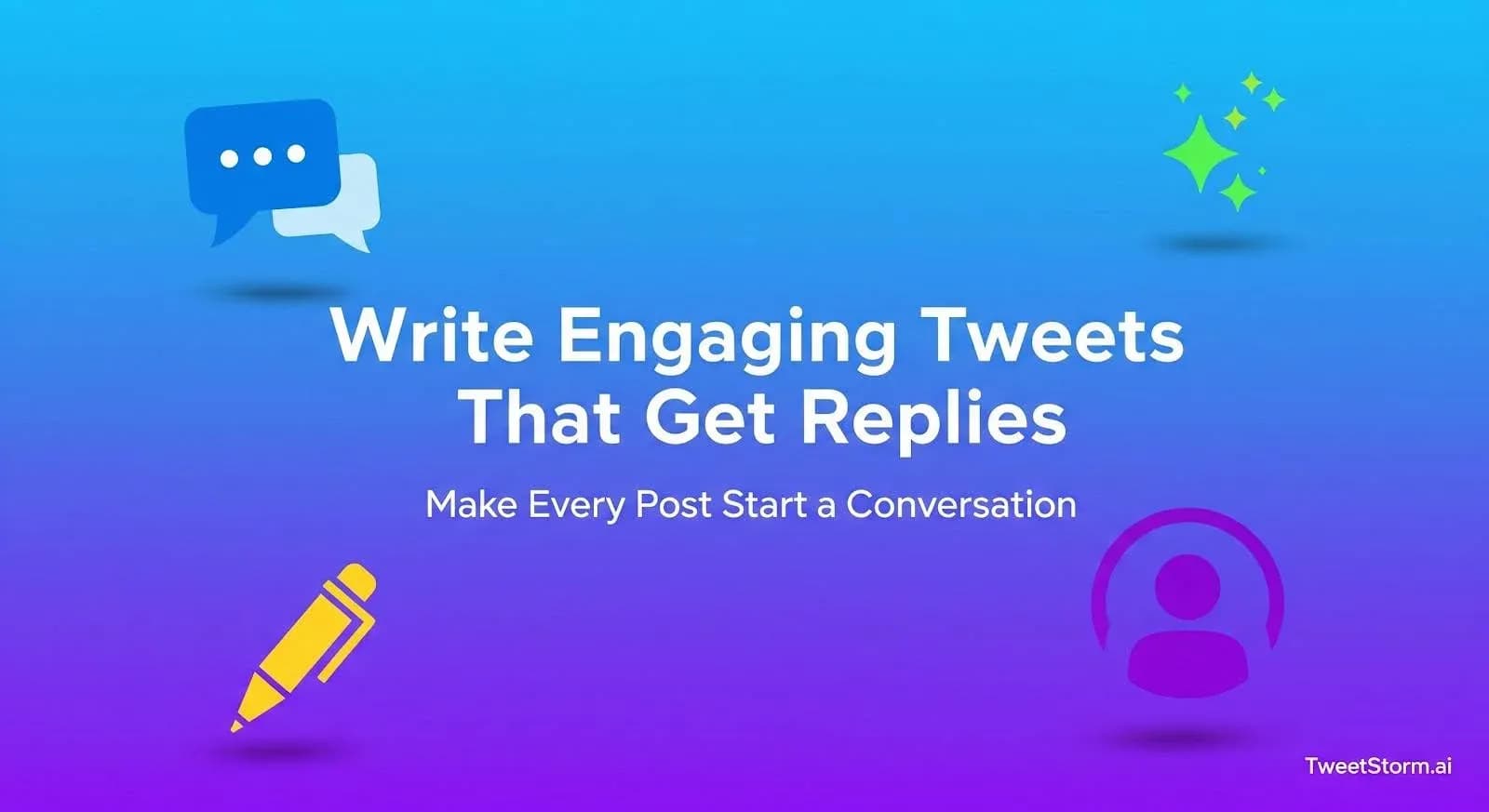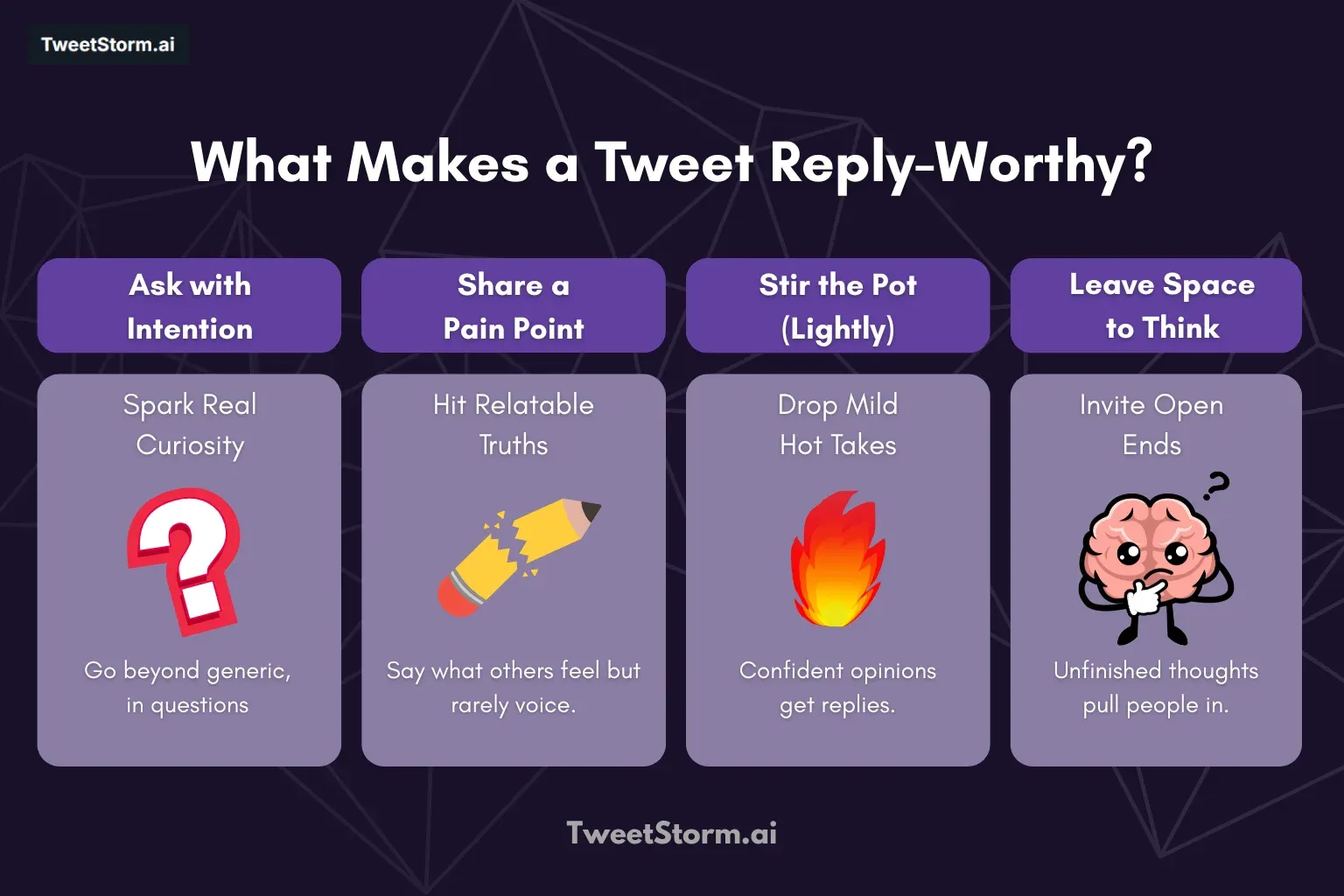How to write engaging tweets that actually get replies?
Ejaz Ahmed
16 Jul 2025 | 6 min read


Tweeting isn’t hard. But tweeting in a way that makes people stop scrolling and actually respond? That’s the real challenge, a viral tweet.
In today's competitive Twitter landscape, likes are superficial. A reply means your tweet genuinely connected with someone, prompting a thought, laugh, question or strong opinion.
And here’s the truth: most tweets don’t fail because they’re bad. They fail because they’re flat. No context, no tone, no reason to reply.
Why do Twitter replies matter? (more than likes)

On Twitter, a like is passive. A reply is intentional. Replies signal an investment of time, which Twitter's algorithm rewards. Reply-rich tweets, often becoming viral tweets, gain extended visibility in timelines and "For You" feeds, even hours later.
But beyond algorithm boosts, replies do 3 powerful things for creators:
1. They spark real conversations
Engaging tweets foster dialogue, making your account an interactive hub with dynamic content.
2. They build real relationships
Replies foster deeper connections than passive engagement, leading to follows, DMs, collaborations or partnerships. This is vital for public builders, product launches or niche audiences looking to create viral tweets. Unlike passive likes, replies initiate relationships.
3. They offer useful feedback
Replies on your tweets act as a comment section and focus group, showing you what resonates with your audience. This feedback helps you craft better future tweets.
What makes a tweet reply-worthy?

Not all tweets invite replies and that’s not by accident. Tweets that earn responses usually tap into one (or more) of these core triggers:
Genuine curiosity drives real engagement
If you want replies, ask better questions. Not just any question, one that feels like it came from a real person, not a social media checklist.
The difference? Intention.
The boring ask
“What’s your favorite book?”
This feels lazy and gets ignored. It lacks direction, context or emotional pull, often scrolled past as a prompt filler rather than a genuine question.
The thoughtful spark
“What’s one book that changed how you approach marketing and why?”
This version works for a few reasons:
- It narrows the scope → more focused replies
- It implies you’ll read the answers
- It invites stories, not just titles
People love sharing what changed their minds. Ask questions you'd want to answer, driven by genuine curiosity, not just engagement, to spark new ideas and learning.
Relatable pain or truth
Share universal feelings in a personal yet relatable way to encourage replies.
Example:
“The real productivity hack? Getting enough sleep. Everything else is noise.”
This works because it’s:
- Relatable (everyone’s tired)
- Slightly contrarian (calls out hustle culture)
- Open for agreement, nuance or disagreement
A tweet like this becomes a magnet for stories, tips and “finally someone said it” replies.
Mildly spicy opinions
Hold a clear, slightly unconventional stance to spark reactions without being controversial.
Example:
“Threads are overrated. 3 sharp tweets > 1 bloated thread.”
Why it works:
- It’s punchy and confident
- It invites debate
- People will jump in to agree or argue, both are replies
Strong opinions make your timeline more memorable, especially when they’re rooted in real experience.
Unfinished thoughts
Sometimes, not completing the thought is exactly what draws people in and makes for viral tweets. Tweets that end with a cliffhanger or a loosely formed opinion invite engagement.
Example:
“I still don’t understand why people obsess over follower counts.”
This isn’t a conclusion, it’s a conversation starter. It subtly asks:
- “What am I missing?”
- “Do you agree?”
- “What’s your take?”
It’s open-ended and leaves space for interaction, which naturally draws replies.
Prompted discussions
Want replies? Ask clear, concise questions. These mini CTAs give people permission to respond.
Try ending your tweet with:
- “Agree or disagree?”
- “What’s missing here?”
- “Hot take or true story?”
- “Your turn.”
This transforms even a simple statement into an interactive post. People are much more likely to reply when the format clearly invites them to.
How to structure a tweet that sparks replies?

Even if your content is gold, formatting makes or breaks engagement. Here’s how to structure your tweets so it becomes a viral tweet and people don’t just read them, they jump in.
Start with a hook
The first line needs to stop the scroll. That doesn’t mean clickbait, it means clarity. Good hooks:
- “Hot take: most advice about ‘audience growth’ is wrong.”
- “Reminder: You don’t have to post daily to stay relevant.”
Lead with tension, insight or a sharp POV, then expand.
Keep it tight
Twitter isn’t your blog. Short sentences win.
- Break long ideas into one-liners.
- Avoid filler intros like “I was thinking the other day
- Use line breaks for rhythm.
Pacing matters more than word count.
Use formatting tools sparingly
Bold caps, lists, emoji or all lowercase? Cool but don’t overdo it.Let style serve the message, not drown it.
End with a cue
Want replies? Make it easy to respond.
- “What’s your take?”
- “Am I off here?”
- “Would love to hear from founders who’ve tried this.”
It’s not needy, it’s human. And it tells people their voice matters.
How TweetStormAI helps you test & optimize replies

Writing one good reply isn’t hard. Writing 30 a day that actually matches the tone, context and brand voice across threads? That’s where most creators fall short and where TweetStormAI steps in.
This isn’t just a reply tool. It’s a full system for crafting, testing and scaling replies that sound human, without burning out.
Instantly generate reply variations (in 19 tones)
TweetStorm's AI Tweet Generator creates diverse reply drafts instantly (Sarcastic, Geeky, Casual, Professional), allowing quick style testing across threads.
Whether you're replying to a founder thread or a meme, you can match the mood without forcing it. No more “same voice every time” problem.
Plug in your keywords to stay relevant
Inject custom keywords like “indexing,” “web3,” “creator stack,” or your product name into any reply. TweetStorm’s Keyword Targeting feature naturally weaves those terms into your tone, keeping replies context-aware, not robotic.
Analyze what’s working (and double down)
Once you’ve posted a few reply variations, it’s easy to scan what’s actually resonating:
- Which tone styles get replies back?
- Which keywords trigger follow-up questions?
- Which replies lead to quote tweets or profile clicks?
Pair TweetStorm with your weekly engagement and suddenly your reply game has data behind it, not just vibes.
Need help tracking past tweet performance? Here’s how to search tweets by date for fast insights.
Final thoughts
To get replies on Twitter, sound like a person, not an ad. Conversations win in a crowded feed. Engage, challenge or spark thought with opinions that aren't loud, curiosity that isn't clickbaity and good flow. These viral tweets are smartly crafted to encourage engagement.
Tools enhance writing by maintaining sharpness, speed and brand consistency. Whether drafting, refining tone with TweetStormAI or testing responses, the goal is to be reply-worthy. More replies mean wider reach, transforming Twitter into a powerful growth platform.
FAQs
1. Why are replies more valuable than likes on Twitter?
Replies are intentional interactions. They signal genuine interest and help your tweets go viral and stay visible longer in timelines. While likes are passive, replies invite discussion and deeper engagement, making them more powerful for growth.
2. What kind of tweets usually get the most replies?
Tweets that feel personal, thought-provoking or slightly opinionated tend to spark conversation and go viral. These include relatable truths, curious prompts, unfinished thoughts and light takes that challenge conventional wisdom.
3. What mistakes should I avoid if I want more Twitter replies?
Avoid long paragraphs, vague takes and overly promotional language. Also, don’t skip the call-to-action, tweets that don’t prompt a response rarely get one.
4. Can TweetStormAI help me generate more engaging replies?
TweetStormAI features a Context-Aware Reply Generator for crafting natural, human-like responses to tweets, regardless of scale.
5. How does TweetStormAI help optimize replies over time?
By analyzing which tones, keywords and structures earn replies, you can fine-tune your approach week by week. The tool gives you both creative speed and a feedback loop for smarter engagement.
6. Is TweetStormAI just for individual creators or can brands use it too?
Both. TweetStormAI is designed to work for solo accounts, startups and brands alike. Whether you’re replying as a founder or managing a brand voice, the tone control and context-awareness keep things on point.